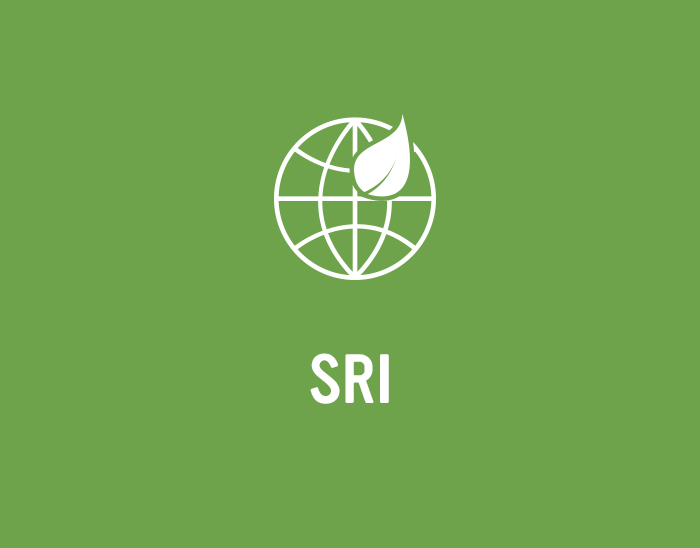
Call to action
Some of Australia’s most significant institutional investors in the socially responsible investment (SRI) space share perspectives on the importance of incorporating environmental, social and governance (ESG) principles in their investment strategies. They also discuss the relationship between ESG and credit ratings, sectoral hurdles and the myths around the risk-return equation.
INVESTMENT SPECIFICS
Craig It would be interesting to get some colour on how ESG investing has evolved at your firms. Is your focus on ESG as a general credit-analysis overlay or do you offer SRI-specific funds?
The EDF has a fixed-income component which currently comprises approximately 44 per cent of the fund. This is made up of international and domestic credit – which is managed by two external managers – and an internally managed, shortduration domestic credit fund. This fund is offered to our church clients.
The Basis of Union established Uniting Church in 1977. UFS began investing ethically in the 1980s and compiled a formal policy in the 1990s, with a significant review in the early 2000s and regular reviews over the last 15-16 years. The most significant review was in 2013, when UFS implemented a fossil-fuels divestment strategy using a three-year time frame.
The investment team is actively involved in the ethical-assessment process, including consideration of ESG factors, to take these factors into account in our investment-risk and valuation analysis.
Our ethical charter defines our investible universe but this does not mean our mandates restrict us to buying green or social bonds. For instance, our fixed-income universe incorporates state-government and Australian Commonwealth government bonds in the Australian market. We are able to buy what is a large, liquid part of the market while at the same time funding health care, education and other socially important aspects of society.
ESG values and beliefs are fully ingrained in the way we think about investments at Altius. I have only been with the firm since June 2017 but it has been a welcome surprise to see the extent of the buy-in from across the team.
Our ESG approach filters through to our mainstream funds from our sustainable-bond fund. We buy green bonds and green use-of-proceeds bonds issued in the Australian market for both. We also have the capability to buy bonds that aren’t strictly green for these funds, but they have to pass our internal ESG assessments.
What we are clearly seeing, though, is increased appetite for traditional SRI product and for the screening of portfolios, albeit under more developed and targeted criteria. Historically, ESG integration was contrasted with SRI practices, which are largely exclusionary. Now the grey area between them is evolving, so higher-risk securities can be screened out on this basis alone. Having said this, our preference is to engage with companies before any screening activity is undertaken.
BT Financial Group became a United Nations (UN) Principles for Responsible Investment (PRI) signatory in 2008, and since this time we have evolved our integration practices. Our approach focuses primarily on engagement. While it is fair to say this has come from an equity-ownership perspective, it is beginning to get some traction in fixed income, particularly with large, institutional fixed-income fund managers.
Five or so years ago, mainstream fixed-income portfolio managers or analysts weren’t across ESG integration. Now we are seeing ongoing analysis and subsequent engagement on fixed-income matters. The bigger institutions are combining fixed-income and equity analysis in engagement meetings – and fixed-income analysts are even engaging directly themselves.
We have been integrating ESG into all our investment processes for more than a decade. We aren’t only concerned with ESG for specific products – we have integrated ESG into each and every investment process across the organisation.
More recently, we have started to investigate the potential for product solutions to meet specific needs, because of the trend towards institutional investors looking for, say, lower-carbon portfolios or portfolios linked to the UN Sustainable Development Goals (SDGs). We think these trends will continue to evolve and we need to be able to develop products to meet these needs.
We believe each asset class is different and the types of companies we invest in require different tools to be able to properly understand the ESG risks and opportunities associated with them. So each investment team has developed the approach that best fits both their existing investment philosophies and the types of assets they are investing in.
In corporate credit, ESG is one factor we consider in our internal credit ratings. It can comprise zero to 100 per cent of the internal credit rating, depending on how material the issues are to the particular issuer.
There is a clear correlation between our ESG assessment and our internal credit ratings. There are also some companies for which we don’t provide an internal credit rating because the ESG risks are so apparent that we see these firms as uninvestible.
If the individual security score is E this doesn’t automatically mean we are unable to buy it. The security may be issued by a company that is transitioning to a low-carbon economy, one that might be doing some good work in other areas of sustainability or it might have good corporate-governance record. It is possible that parts of a business bring the rating of the whole down.
It’s more likely than not that a company with an E score won’t be in the portfolio, though. It tends to be the instruments scored C and D that our ethical investments monitoring committee – the committee that discusses all our exposures from an ethics perspective – talks about the most.
Stakeholders step up
Institutional investors’ end clients are becoming increasingly engaged with the socially responsible nature of their investments.
WONG From both. Altius Asset Management’s beliefs and values have ESG firmly embedded in them. But investor demand is also increasingly acting as a driver.
There are a range of factors at play. Since the adoption of the Paris Agreement there has been growing recognition that the financial sector has a role to play in the transition to a low-carbon economy. There is a
group of institutional investors that are drawn to companies which have clear social and environmental objectives and good ESG practices. This group is only going to grow.
BERRUTTI Engagement is growing from a low base and there are real differences between leading asset owners and the rest.
In the early days we believed integrating ESG was a better way to invest because we could make better-informed investment decisions. We did this even though there was limited client interest. Today we find it comes from both sides. We see increasingly obvious risks and opportunities associated with these issues for the companies we invest in, but at the same time there is a growing push from clients to have robust processes for considering ESG issues.
CREDIT ANALYSIS
Craig Is there much evidence to support the idea that a commitment to ESG factors and strong financial performance are interlinked?
If you accept a couple of high-level points as given – there is value at risk from potential ESG risks to a corporate and there is information outside traditional analysis that could have an impact on investment performance – the process becomes one of working out how we can get access to more informed analysis and information, and how we establish its potential materiality to a company.
Yes, we have seen an evolution in the data available from service providers in the ESG space, though it is still in its infancy in comparison with the quality and breadth of standard data available to investors. Logically, having satisfied some criteria on the quality of the information, the question becomes ‘how’, not ‘why’, I should include this data in analysis, in a way that it best fits exposures and the type of company and environment the company is operating in.
Proof points are important but if we wait for decades of evidence, given the evolution happening in this space and the types of nonfinancial data points we are talking about, the point of ESG integration will have been missed.
Craig How are investors incorporating both quantitative and qualitative findings into their risk assessments of companies?
We also want to know if there are likely to be any positive shock events or structural changes to balance sheets. For example, whether resource-driven companies are actively seeking ways to transform their balance sheets as part of the transition to a low-carbon economy.
Green bonds support the transition to a low-carbon economy. We observe many companies seeking ways to manage and fund their balance sheets and allocate capital. We are supportive of engaging with companies around how they’re transitioning towards a low-carbon economy, including through the issuance of green bonds.
We certainly find this benefits us when it comes to avoiding default. If you invest in our global credit fund the default experience is much lower than if you invested according to the buckets the rating agencies provide.
We have published these findings for the last three years in our responsible-investment report.
Through the 15 years I have been undertaking credit analysis into ESG, it is particularly the ‘G’ risks that can and do have an impact for corporates in our credit funds.
Craig Do others find governance has more of an impact on the credit view than environmental and social issues?
We see this with green bonds. Originally the bonds performed in line with regular issuance from the same
organisations. As the market has responded to the increase in issuance, green bonds are performing better. There seems to be something deeper going on even where there is full recourse to the parent issuer.
There is a real desire by investors to gain exposure to environmentally and socially positive investments. These offer lower risk over the long run because when governments come to regulate these issues you are less likely to be caught out if you align your interests with the broader interests of society.
Measuring up
Investors say the United Nations Sustainable Development Goals (SDGs) are useful for measuring impact, but matching the 17 global goals and 169 individual targets is a challenge. Their firms are developing their own approaches to gauging impact.
WONG SDGs are one way to measure impact. It goes a lot further, though, because what we need to do is build a sustainable and resilient future for all the people on the planet. I think this is an important call to action for all countries and stakeholders.
Even so, measuring impact is difficult as there is no single measure that can capture the benefit to society. This is why the SDGs are useful, because they break the measurement down into several different goals and targets. But it is also important not to neglect other areas when you’re addressing one goal or target.
BERRUTTI We don’t have specifically targeted SRI products, as we look to integrate environmental and social governance (ESG) across our investment processes.
The asymmetric nature of bond investment returns and risks means fixed-income investors naturally focus more on the downside, meaning it’s somewhat unnatural for fixed-income investors to focus on the positives.
In addition to shifting mindsets, good-quality information is important. However, measuring impact is still a relatively new concept. We are looking for data providers that can give us some insight although sourcing
good-quality information is challenging.
RISK AND RETURN
Craig What is your response to those who think you have to give up returns to invest responsibly?
This is unsurprising. A focus on businesses creating a better future helps build portfolios of companies with robust growth prospects and helps avoid companies exposed to a higher risk of negative action from consumers and government.
If you look at various approaches to responsible investment, which invariably include screening or tilting
portfolios, there is evidence coming from, say, carbon-tilted portfolios that you are able to minimise tracking error to a broad mainstream index without significant detraction, if any, from the return outcome. Many approaches are being adopted and we are seeing a lot of action by index providers and active managers alike to develop carbon-tilted portfolios.
The answer is also linked to the time horizon and governance capability of the investor. It’s important that those seeking to link their own responsible-investment preferences and motives are sufficiently resourced or seek appropriate support to ensure their portfolios reflect those preferences in the best possible way and they are aware of the potential outcomes.
Investment techniques are getting better at integrating responsible-investment priorities and identifying and managing potential impacts on returns.
The largely buy-and-hold nature of our investments means we seek smooth, long-term returns and lower volatility. Investing ethically and responsibly over the long term can provide these.
Part of the reason is that responsible investment has a religious and ethical history, where avoiding harmful industries was the focus and the financial consideration was secondary. Mainstream investors believed anything that reduced the investible universe must detract from performance. But on average these types of strategies haven’t underperformed. This suggests manager selection, rather than whether or not they are running an SRI strategy, is a greater influence on performance.
However, since the establishment of the PRI, investors have increasingly recognised the value that can be added through integration of ESG factors as a financial consideration. Rather than a trade-off, they recognise companies with good employee engagement, community relations and environmental stewardship will perform better over the long run.
Interestingly, we are now seeing some overlap between these approaches. This emerging trend is a recognition that issues like corporate conduct or climate change can significantly undermine the integrity of financial, economic, social and environmental systems as well as pose risks for the individual firm. It also recognises that investors can influence better outcomes through the allocation of capital and active ownership, and so have stewardship responsibilities. It is for these reasons we are seeing increased focus on SDGs as an investment framework.
MARKET DEVELOPMENT
Craig Is there enough product to fulfil your demand for SRI? Would you like to see more offerings in the Australian market, or can you buy green and social bonds offshore?
We have a stated intention to support the transition to a low-carbon economy and allocating capital towards green bonds helps with this transition as well as fulfilling our ethical principles and policy.
Social-benefit bonds also form part of our EDF. We have participated in four transactions in 2017 and we think there’s a good opportunity for continued growth. Transaction volumes are small but industry collaboration between investors and issuers could support the typical A$5-10 million (US$4-7.9 million) current deal size reaching A$50 million or more.
There is a lot of discussion around SDGs and, at the very least, trying to articulate how to align investments to these goals. In fixed income, developing the range of strategies beyond green-bond structures should be a significant opportunity for issuers and fund managers.
While green bonds have grown significantly they still only represent about 1 per cent of overall bond issuance. This means the scale of green-bond issuance must grow sufficiently to be transformational.
There is also some product which, even though it carries the label, isn’t necessarily green. Equally, many issuers have a positive social or environmental impact but they don’t label their bonds green or social. While it is great to have an increasing amount of product, partly because it allows for easy identification, there are still opportunities for fixed-income investors to look more deeply at the existing capital markets for SRIs.
Business leads
The political environment is a clear constraint on Australia moving to a low-carbon economy. So business is taking over.
KELLY Australian climate policy is a disaster. Having said this, investors and issuers are getting on with the job. I would point to the progress of green bonds in Australia. We have banks that are willing to fund
and investors that are willing to back green bonds.
Another factor to consider is how Commonwealth government policy failure can be mitigated by state-government energy targets.
MOORE The federal government has agreed to certain targets within the Paris Agreement and as a country I think we’ll continue to collectively aim for these.
I agree with Tim Kelly that, in the absence of government actions, the states have not only taken this on but are delivering. We’re seeing this in South Australia and I think we will begin to see it in other states too.
FUTURE CHALLENGES
Craig It is clear we need exponential growth in the level of investment – including but not limited to green bonds – to transform the global economy. What other challenges are there to the development of the impact-investment market?
The Financial Stability Board has carried out a lot of work via its Taskforce on Climate-Related Financial Disclosures. This aims to develop consistent, climate-related financial risk disclosures for companies to provide information to investors, lenders, insurers and other stakeholders.
This is voluntary for companies, which means there will be challenges for asset owners and investors to try to encourage companies to report on climate-change issues as well as to challenge them to do this as part of their normal reporting requirements.
Another challenge is finding a high-yield bond manager that does ESG well.
A degree of sophistication supported by data improvements should assist in better risk management.
Gaps in regulatory oversight and a lack of recognition of the financial risk of climate change may exacerbate this challenge. We are hopeful, though, that this will change with the Australian Prudential Regulation Authority acknowledging the potential financial risk for banks, insurance entities and the funds-management industry including superannuation. In the near term we hope the interpretation of updated fiduciary obligations will act as a long-term positive driver.
Our biggest concern is superficial integration – the tick-the-box exercise – of ESG. There are organisations that offer SRI or ESG-type products but that are poorly resourced – they have very little specialist ESG personnel. This could damage the SRI industry’s promise of offering a true risk assessment of ESG.
There is a bifurcation between truly sustainable and ESG-tinted mainstream investment portfolios. An increasing number of investors are considering ESG issues in mainstream portfolios but not necessarily with a sustainable-development focus. They are looking at the incremental gains they can achieve through the incorporation of ESG issues in their investment decisions but not at the scale of some of the challenges we face. So there are some big questions around adequacy.
Organisations like World Bank and World Economic Forum publish report after report outlining the significance of these challenges. A total of 168 countries has ratified the Paris Agreement on climate change, which calls for net-zero emissions by 2050 and requires a significant shift in the economy. Even more countries support the SDGs, which also call for significant shifts in the way economies function. Yet mainstream financial markets by and large still seem to be unprepared for and uncommitted to these changes.
The culture and conduct of investment markets isn’t necessarily conducive to sustainable investment due to the prevalence of short-termism. Returns are benchmark-relative and in this context we should be asking whether we are even using the right benchmarks.
The quality of information is improving but good-quality ESG research is hard to find and the bulk of it is targeted at equity investors. It is particularly hard for bond investors to find information on subsidiary companies or unlisted entities.
There is also an educational component. Within the CFA designation the amount of training on ESG integration is very small relative to the rest of the programme.
The history of ethical investment has also caused its own challenges. Analysts would screen out ‘nasty’ investments before handing over to a portfolio manager, who would not really consider ESG issues.
This is essential both internally, for more effective sustainable-investment management, and externally for public transparency and accountability for the difference we make.

WOMEN IN CAPITAL MARKETS Yearbook 2023
KangaNews's annual yearbook amplifying female voices in the Australian capital market.
















